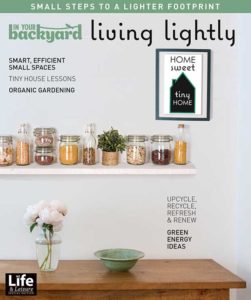Take a tour of fabric upcycler Sarah Lancaster’s cute-as-a-button tiny house
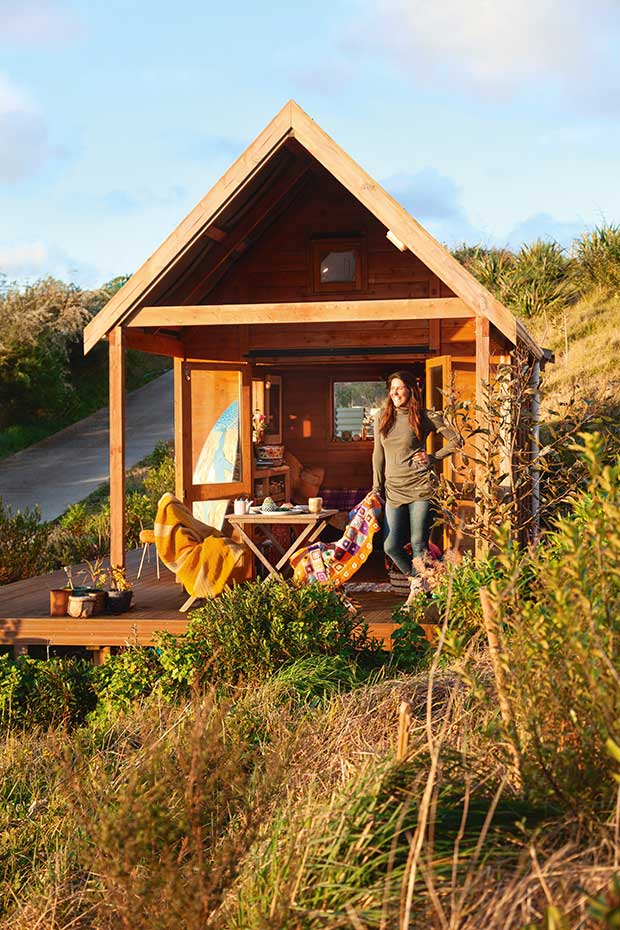
A sewing teacher with a superhero-like enthusiasm for saving the planet packs a heap of personality into her tiny house.
Words: Emma Rawson Photos: Sally Tagg
Life is crammed into Sarah Lancaster’s tiny house. In every direction there are swatches of primary-coloured fabric from the 1970s, 1980s and 1990s, the ceiling is draped with a felted flower chain and a side table is home to both a ukulele and a recycled plastic vase with a face stuck on it.
Space is tight, but the three-metre-by four-metre house is bright and beautiful. Her home shows the result of years of rescuing treasure from trash piles and transforming rags into soulful sewing. Ball gowns and bridesmaids’ dresses, discarded after their one big night out will, in Sarah’s creative hands, become bum bags or shopping totes.
This op-shop Rapunzel spins faded beach towels into ponchos for surfies, pillowcases into produce bags. She does this often from the deck of her teeny Raglan home and sells them online and at markets through her social enterprise business, Sew Love.
“In the past few decades we’ve seen the rise of ‘fast fashion’ and a culture of throwing away clothes and buying new, and it’s resulted in a lot of used fabric going to landfill,” says Sarah.
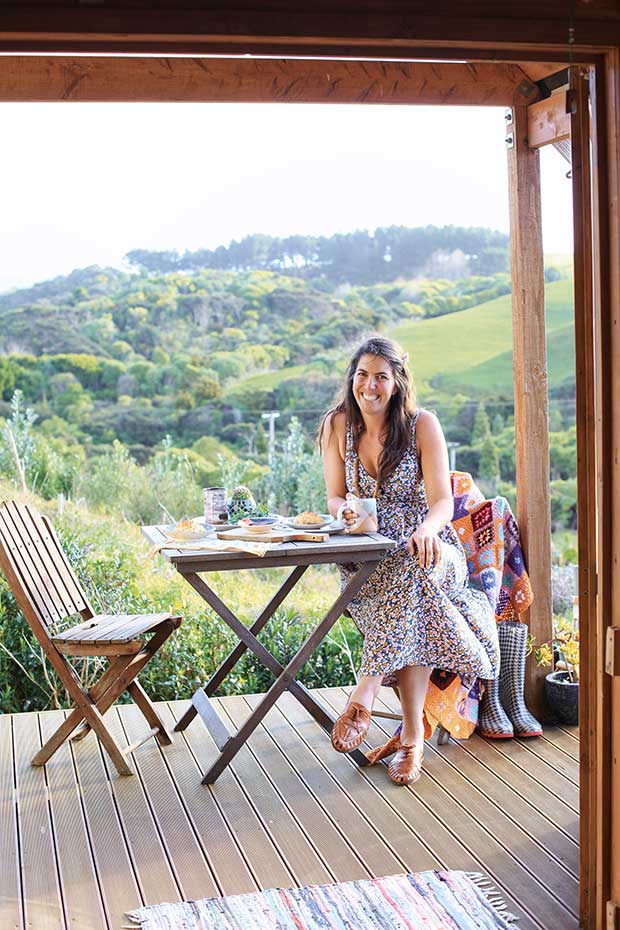
Sarah Lancaster’s home looks out over Mt Karioi, near Raglan. The deck acts as an extended living area and helps her feel closer to nature.
“Sew Love is my way of getting excited about alternative ways of consuming things, dressing and expressing ourselves with more awareness. “This social enterprise has not only helped me live my passion, but I pay my rent with it, and I’m grateful for that.” Sarah views her tiny house as a mansion — it’s undoubtedly luxuriously large in comparison with her 1984 Mitsubishi Canter caravan.
She spent two summers touring New Zealand in the solar-powered campervan (nicknamed Cecil) teaching basic sewing and mending skills. As many as 10 people squeeze around Cecil’s fold-out picnic table under the awning, or inside at the dining table for lessons. Pupils use sewing machines (each is named: meet Georgina the Bernina and Boris the Brother) powered by a solar panel on the roof.
At night the classroom and piles of recycled fabric are packed away, and the workshop becomes Sarah’s bedroom. The next day she drives Cecil (young at heart, but a bit slow on the winding hills) to the next town, to spread the word about recycling and sustainability.
“Sewing is a forgotten skill. I talk to many women who say their mothers never taught them to sew. That’s probably because their mums were trying to show them how to be independent women and reject domesticity, but sewing, making and mending is empowering.
“My classes are about relearning those lost skills, expressing creativity and getting people excited about reusing and giving things another life.”
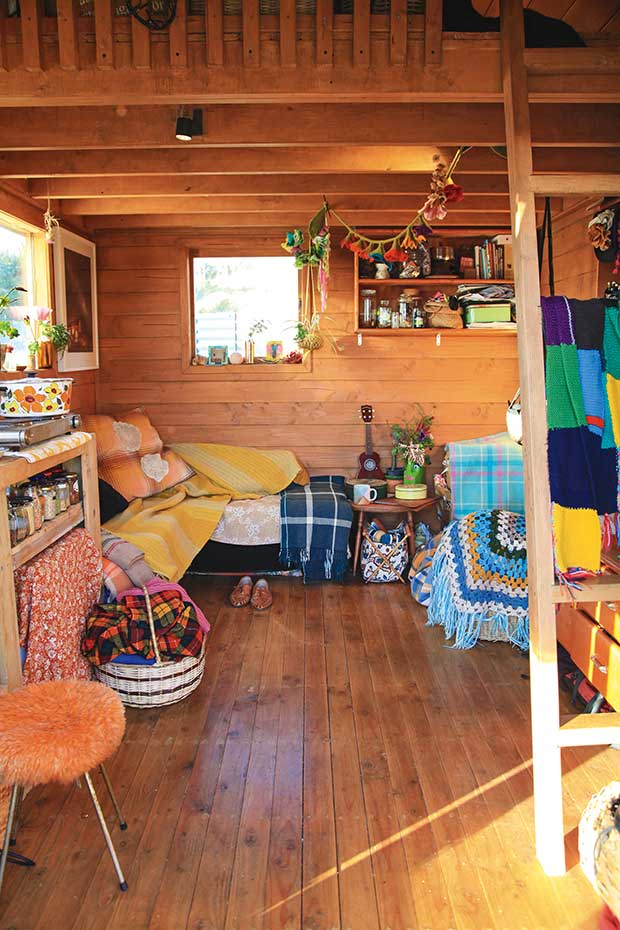
During the school term, Cecil is parked up as Sarah becomes a real-life superhero called Lady X. Although she doesn’t wear a cape in her job teaching sustainability to Waikato school kids on behalf of Raglan’s Xtreme Zero Waste Recycling Centre, if she did, it would be made of patchwork Hawaiian print and sequins. Her classes teach kids about the Earth’s natural resources, the products they use in daily life and the resulting waste.
Lessons to demonstrate composting can involve her transporting tiger worms to schools inside a 1970s casserole dish. Sarah’s educational background includes a Bachelor of Arts from Auckland University, majoring in theatre studies and English and certificates in garment and pattern-making from NZ Fashion Tech. But she learned her biggest lessons about sustainability as a child growing up in Thames.
Family holidays were spent at beaches in the Coromandel, sailing in the Hauraki Gulf and tramping in nearby forests. Her mum was an upcycler before it was fashionable.
“Mum is a great sewer, and I grew up watching her do things like reupholster 50-year-old chairs. And she helped me make model aquariums from recycled shoe boxes and cellophane — she is really creative.”
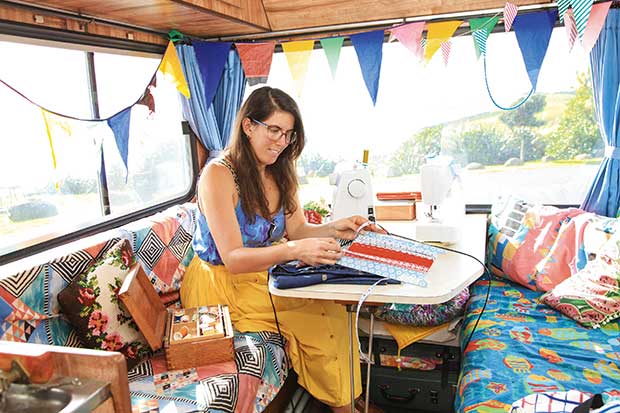
It’s these childhood experiences that make Sarah passionate about her work.
“We need to show kids how precious nature is and get them to fall in love with the Earth. If they love the trees, rivers and coastlines, they will protect them.” One of the reasons Sarah loves her tiny house is that it brings her closer to the natural environment.
There’s no escaping the elements in a tiny house, and during a storm, the whole building shakes. The outdoor shower and composting toilet make winters harsh, but she’s grateful for her life. “I’m so much more aware of the outside world in the tiny house. Because there’s not much space inside, I find myself going out more and participating in the community. I notice the seasons more than I used to.”
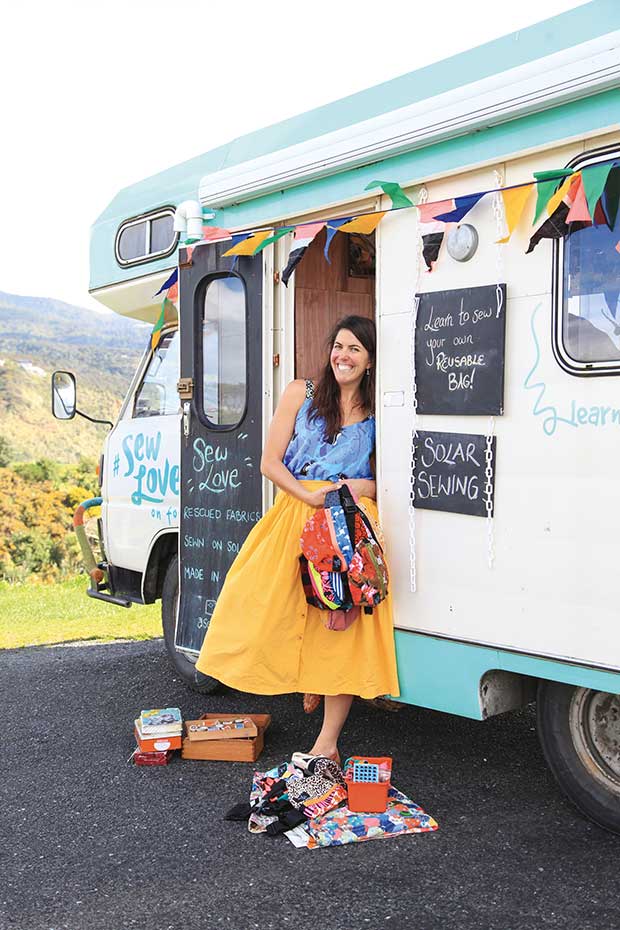
Although she’s currently renting her home from friends, Sarah says she’s in the tiny-house community for the long haul and hopes to one day build her own small home. When she does, it will have more hidden storage (her current home lacks places to stash away fabric) and “mod cons” like indoor running water — she currently washes dishes in a bucket using boiled water. “Some people use tiny homes as a stepping stone to owning a traditional-sized house, but I’ve seen initiatives where people share amenities, and it’s something with which I want to continue to
be involved.
“My boyfriend and I often talk about an adventure to build a small eco-friendly home together — a yurt or a tiny house. We are already collecting recycled wood floorboards and stained-glass windows to repurpose for a future build.”
TIPS FOR TINY LIVING
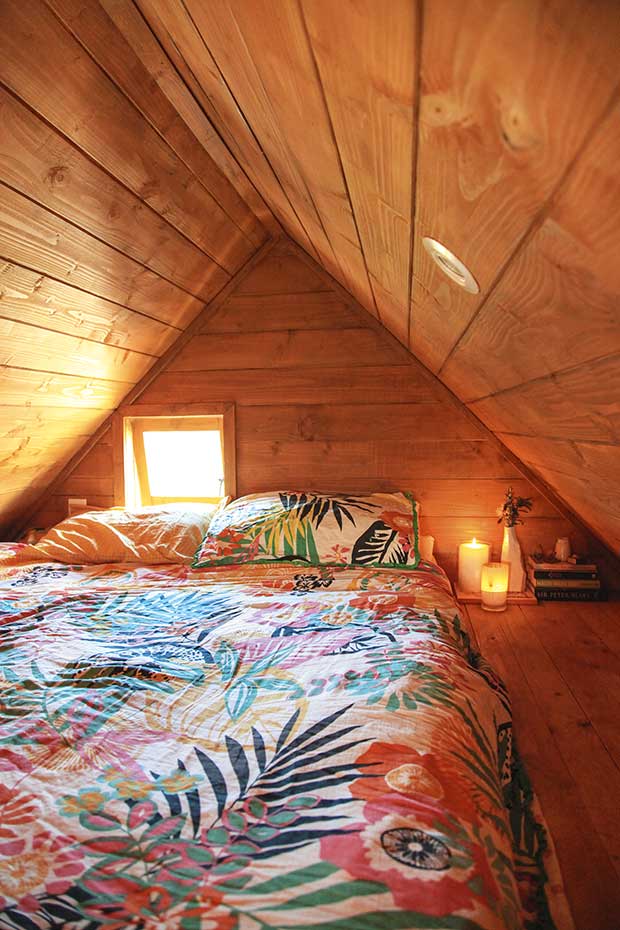
With space at a premium, Sarah is conscious of everything brought into her home. Although one of her favourite past-times is finding clothes at op shops, she’s careful not to collect more goodies than she has room for.
When she hosted a potluck party at her tiny house, she bought cutlery and plates from her local Xtreme Recycling Centre for $1 each. After the party was over, she washed and returned all the items to the store. Living tiny takes some discipline, she says. “When your life is chaotic, it’s quickly chaotic in a tiny house. Keeping tidy leads to a good frame of mind. I need a space in my home for dreaming up new ideas and planning. In this house, it’s my couch area. And I try not to do my work in that same space.”
THE ENVIRONMENTAL COST OF CLOTHING
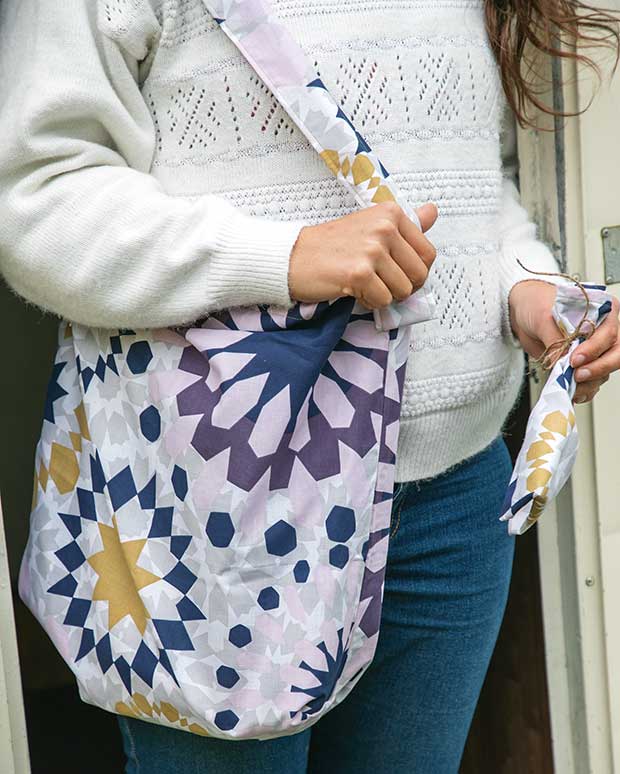
Ministry for the Environment figures from 2008 estimate that textiles and apparel account for four per cent of waste sent to landfill. A 2017 report from the British charitable organization, the Ellen Macarthur Foundation, says consumption of “fast fashion” is rising, and that 60 per cent of fast-fashion clothing purchases is thrown out within a year.
Fast fashion refers to the practice of apparel chains releasing cheap seasonal clothing lines, with new items weekly. This leads to shoppers buying more, which they keep for less time, resulting in more wastage. The United Nations Economic Commission for Europe reports that the “fashion industry is responsible for producing 20 per cent of global wastewater and 10 per cent of global carbon emissions”.
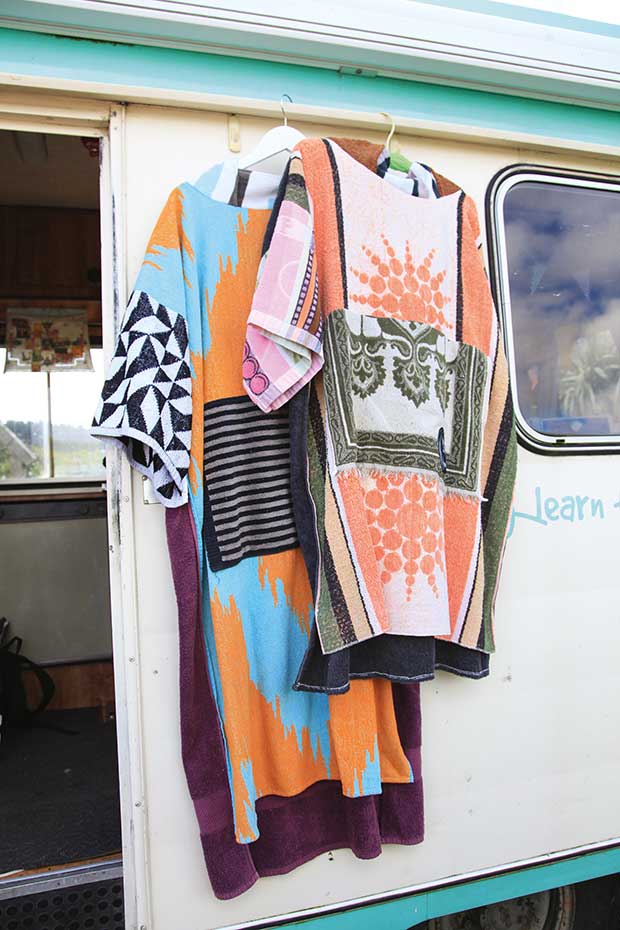
It also estimates that half a million tonnes of plastic microfibers shed during the washing of plastic-based textiles such as polyester, nylon and acrylic end up in the ocean every year. Sarah says it’s easy to feel discouraged by the facts of fashion as the global supply chain is often confusing. She encourages people to look for “slow fashion” clothing labels, which have transparent manufacturing and fabric sources and to look out for recycled clothing opportunities. “Op shops and charity stores are treasure troves,” she says.
Learn more about reducing waste and sustainability in our special edition, In Your Backyard: Living Lightly.
This practical guide is filled with advice on how to take small steps towards a lighter footprint, including how to go plastic-free, upcycling and recycling. PLUS ideas for tiny-house living, root-to-leaf recipes, green-energy generation, organic gardening, and how to raise chickens and keep bees in the city.
READ MORE
Japanese Furoshiki: An eco-friendly alternative to paper gift wrapping
 This article first appeared in NZ Life & Leisure Magazine.
This article first appeared in NZ Life & Leisure Magazine.
